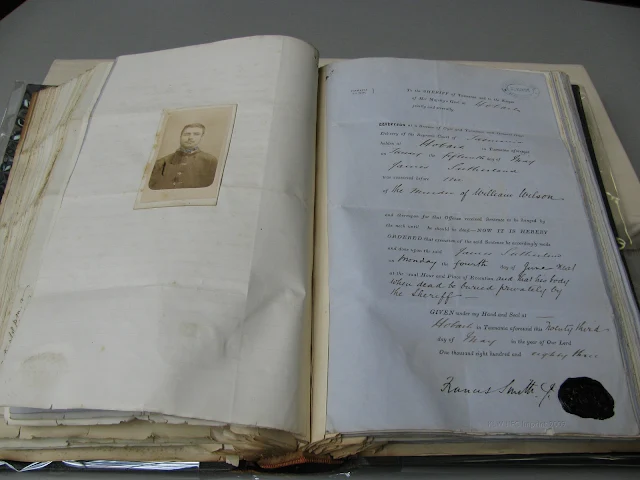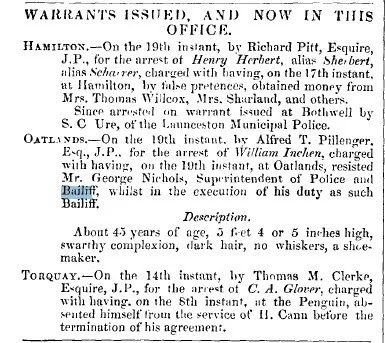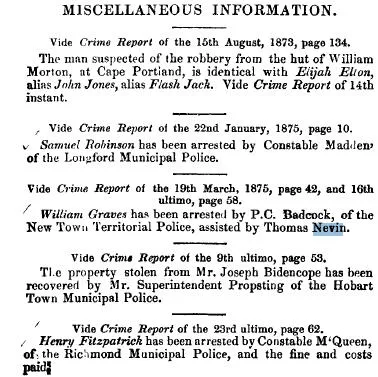HER MAJESTY'S GAOL HOBART
The Nevin Brothers, Thomas (T. J. Nevin, 1842-1923) and John (W. J. Nevin, 1852-1891) served the Police and Prisons Departments of the Tasmanian government from the late 1860s to the late 1880s. Thomas was contracted as prisons and police photographer by the family solicitor, Attorney-General and later Premier, W.R. Giblin, from 1868, serving the New Town Territorial Police and the Municipal Police, as police photographer (1870s), and during the Chiniquy riots at the Town Hall as special constable (1879). He was also assistant bailiff in the City Police Court and Supreme Court (1880s).
The boy in this stereograph (figure on viewer's left) is Jack Nevin, later Constable John Nevin (William John), younger brother of commercial and police photographer Thomas J. Nevin. Jack is pictured standing next to a prison official who was probably Mr T. P. Ball, Superintendent of the Prisoners Barracks in 1857 at the Campbell Street Gaol.

Hobart Gaol, Campbell St.
Location: W.L. Crowther Library
State Library of Tasmania ADRI: AUTAS001125299420
Family Photographs
Younger brother Jack Nevin's signature pose in this photograph - left hand on hip - also appears in a family group photograph taken a decade later:

Caption:
This is a very young Jack Nevin ca. 1865, later Constable John Nevin in his favorite pose - left hand on hip - at the Hobart Gaol. Detail of stereo by his older brother Thomas J. Nevin (State Library of Tasmania)

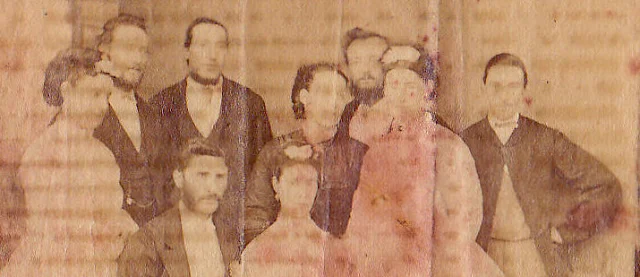
The Nevin Group Portrait ca. 1870s (detail):
Jack Nevin, top right, Thomas Nevin seated
Copyright © KLW NFC & The Nevin Family Collections 2009 ARR
This is a detail of a group photo, taken in the early 1870s, around the time of Thomas and Elizabeth Nevin's wedding, July 1871, printed on thin paper and unmounted. Thomas and Elizabeth Nevin are both seated, with younger brother Jack Nevin standing in his signature pose, hands on hips again, on viewer's extreme right. The other members of this group may have included Mary Sophia Day, Elizabeth's younger sister, and photographers Alfred Bock and Samuel Clifford.
Constable John (Jack) Nevin was his elder brother's assistant at the Hobart Gaol, Campbell Street during Thomas Nevin's commissions as police photographer in prisons and police courts from 1876 when Thomas Nevin leased his commercial studio and set up studios at the Hobart Gaol and Municipal Police Office, Town Hall. He helped maintain one of their photographic studios in New Town, assisting in the production of stereographs and studio portraits intermittently from the 1860s to the late 1880s. He was employed at the Hobart Gaol under the supervision of the keeper Ringrose Atkins from 1874, and became a Constable on salary at the male prison at Cascades and then at H.M. Prison, Campbell St. Hobart in 1875, serving until his untimely death from typhoid fever at age 39 in 1891.

Constable John (Jack) Nevin ca 1874-6
Photographed by his brother Thomas Nevin
Copyright © KLW NFC Imprint Shelverton Private Collection 2006-2009 ARR.
In this image on thin paper and unmounted, Jack Nevin's brother Thomas captured him in a relaxed standing pose leaning on a book, the usual signifier of literacy in 19th century portraits, wearing a shirt, tie, fob watch, and three piece suit with velvet collars. In the later photograph (below) taken ca. 1880, Jack Nevin looks very relaxed and very savvy about the process of being photographed. His gaze is direct and very keen, his clothes suitable for everyday work in a foul place such as a prison. His salaried positions were primarily in administration, with a career path and ranking similar to the Keeper's. Older brother Thomas Nevin had been a Keeper too of a public institution, at the Hobart Town Hall between 1876-1880; a special constable during the Chiniquy Riots of 1879; Office Keeper for the Hobart City Corporation; and assistant bailiff in the courts during the 1880s. Constable John Nevin's presence at the Hobart Gaol points to a close family involvement by both Nevin brothers with prisoner documentation - visual and written.

Constable W. J. (Jack) Nevin ca. 1880.
Photo taken by his brother Thomas Nevin
Copyright © KLW NFC Private Collections 2009 ARR
In the Constabulary
This record of Jack Nevin's application to the Constabulary Tasmania, signed by the Sheriff on 28th February 1877, not only gives details of Jack's former employment at the Cascades Goal for Males between August 1875 and April 1876, it details his physical characteristics: aged 25, single, height nearly 5ft 6", educated but not too well, a labourer by trade, a Wesleyan by religion and Belfast born, arriving free on the Fairlie (1852). He was of course no more than a babe in arms in 1852, noted on the ship's sick lists, but this record shows no physical deformity or disease as an adult. These records are crudely categorical, as we know that Jack Nevin was highly literate, the son of a journalist and poet, and brother of spelling-bee whizz, his sister Mary Ann, and brother too of Thomas, a police photographer with powerful political mentors. Because he was an amateur rather than professional photographer, his trade is listed as "labourer", i.e. no specialist apprenticeship or profession.

W.J. Nevin Applications to join the Constabulary Tasmania 1877 and 1881
Records courtesy State Library of Tasmania
While a constable at the Cascade Gaol for Males, Constable Nevin was involved in an incident which was reported in the Mercury, 27 October, 1875:
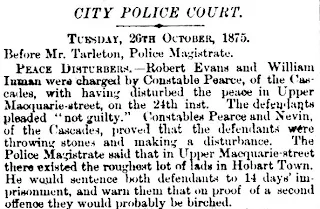
Constable Nevin, Mercury, 27 October 1875.
TRANSCRIPT
CITY POLICE COURTOn 24th November 1881, Jack Nevin's second application - a renewal of the 1877 application - to the Constabulary Tasmania was again signed by the Sheriff. Aged 27, his details are more general on this form: religion is listed simply as "Protestant" and birthplace simply "Ireland" but he is still single - living with his parents at Kangaroo Valley - and still free of disease or deformity. His service at Cascades and the Hobart Gaol is listed, as is the lack of a trade. On his death certificate, his employment was registered as "Gaol Messenger", a rank which covered photographic duties and office administration.
Tuesday 26th October, 1875
Before Mr. Tarleton, Police Magistrate
PEACE DISTURBERS. - Robert Evans and William Inman were charged by Constable Pearce, of the Cascades, with having disturbed the peace in Upper Macquarie-street on the 24th inst. The defendants pleaded "not guilty". Constables Pearce and Nevin, of the Cascades, proved that the defendants were throwing stones and making a disturbance. The Police Magistrate said that in Upper Macquarie-street there existed the roughest of lads in Hobart Town. He would sentence both defendants to 14 days' imprisonment, and warn them that on proof of a second they would probably be birched.


Signed 24th November 1881, Constable (Wm) John Nevin's second application - a renewal of the 1877 application - to the Constabulary Tasmania. Records courtesy State Library of Tasmania.
Death by Gunshot Wound at the Quarry 1882

View from the hill above Quarry to the Hobart Gaol
Courtesy Archives Office of Tasmania
Ref: 30-5718c. Unattributed, ca. 1885.
On the 14 May 1882, Constable W. J. Nevin was on duty at 11.45am when the guard in the sentry box on the hill at the Quarry behind the stone-shed near the Hobart Gaol failed to return. Constable Nevin was dispatched to investigate and found the guard, Frank Green, dying of a gunshot wound. "I am shot, John" were Green's dying words as Nevin lifted his head.
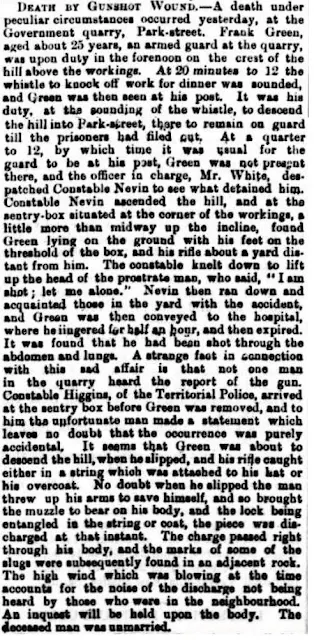
Constable Nevin and Constable Green
Death by Gunshot Wound
Mercury, 15 May 1882
TRANSCRIPT extract
... At a quarter to 12, by which time it was usual for the guard to be at his post, Green was not present there, and the officer in charge, Mr. White, despatched Constable Nevin to see what detained him. Constable Nevin ascended the hill, and at the sentry-box situated at the corner of the workings, a little more than midway up the incline, found Green lying on the ground with his feet on the threshold of the box, and his rifle about a yard distant from him. The constable knelt down to lift up the head of the prostrate man, who said , "I am shot; let me alone. " Nevin then ran down and acquainted those in the yard with the accident, and Green was then conveyed to the hospital, where he lingered for half an hour, and then expired. It was found that he had been shot through the abdomen and lungs ...Frank Green was 21 yrs old, rather tall, a Catholic, single, born in Hobart and a former sailor when he joined the Constabulary for the first time, signed in by the Sheriff on October 1st, 1878.

Frank Green application to join the Constabulary Tasmania 1878
Courtesy State Library of Tasmania
At the inquest held at the Bird-in-Hand Hotel five days later, Constable John Nevin was a key witness. The jury of seven reached a verdict of accidental death. Coroner Tarleton found the guard Frank Green had slipped when about to descend the hill and his double-barrelled breech-loading gun had caught in a string on his coat, discharging a bullet through his abdomen and lung.

Inquest at the Bird-in-Hand, Const. W. J. Nevin's deposition
The Mercury 19 May 1882
Further report of the Coroner's findings on the death of Constable Green
The Tasmanian (Launceston, Tas. : 1881 - 1895) Sat 20 May 1882 Page 547 TASMANIA.
Electoral Roll 1884
The Electoral Roll of the Electoral District of North Hobart, year commencing 11th April, 1884, showed this entry:
NEVIN, William John
Place of Abode: H.M. Gaol
Nature of qualification: Salary
Particulars of Qualification: H.M. Government

Nevin, William John: Electoral Roll for North Hobart 1884.
Source: Archives Office Tasmania
mfmN206 Tasmania Electoral Roll
SLTX/AO/EP/425 (NLA)
Vols: 1884-85;1886;1886-88
.jpg)
The Royal Arms insignia on this document and which appeared on all government documents in 19th century Tasmania also appeared on Thomas Nevin's government contractor studio stamp when printed on the verso of convict identification photos taken at the Port Arthur prison and Hobart Town Gaol for the Municipal Police Office, Hobart Town Hall, and on several of his portraits of officials and their families in the employ of the Hobart City Corporation (Mayor's Office, Hobart Town Hall).
Recto and verso of photograph of prisoner Wm Smith per Gilmore (3)
Verso with T. J. Nevin's government contractor stamp printed with the Royal Arms insignia.
Carte numbered "199" on recto
QVMAG Ref: 1985.p.131
The Keeper of H. M. Gaol, Hobart, from the 1st January 1874 was Ringrose Austin Atkins (see record above). He was listed on the Electoral Roll for North Hobart for the year commencing April 11th, 1884 on "salary", and resident at the Gaol in Campbell Street. The gaol was conventionally known as the Campbell Street Gaol [CSG]. In the same year, 1884, William John Nevin was also listed on "salary" at H. M. Gaol, Hobart, and also resident there. His position is not listed, but it is clear that he was in training as Keeper under Ringrose Atkins' supervision. The term "Keeper" denotes a manager of an archive: it is still used as a position title at the Public Records Office of Victoria.

Hon. W. R. Giblin ca. 1874
Photo by T.J. Nevin (verso stamped)
Archives Office of Tasmania Ref: NS1013-1-1971
Family solicitor and mentor to the Nevin brothers, Attorney-General W. R. Giblin (1840-1887)

Map of the old Hobart Gaol
Photo copyright © KLW NFC Imprint 2008 ARR
Click on thumbnail for large view
City Police in Uniform, Hobart, late 1880s


City Police, Hobart
Images courtesy Archives Office of Tasmania
Unattributed, ca. 1885
Refs: (top) NS1013-1-19 (below) NS1013-1c.
RELATED POSTS main weblog
- The first Rogues' Galleries
- Convict cartes by Thomas Nevin at the new National Portrait Gallery
- Thomas Nevin's hand-coloured convict photographs
- Nettleton and Nevin patents registration
- The trial of Joshua Anson
- Nepotism, corruption and Port Arthur 1873
- W.R. Giblin, Judge, Attorney-General and Premier

